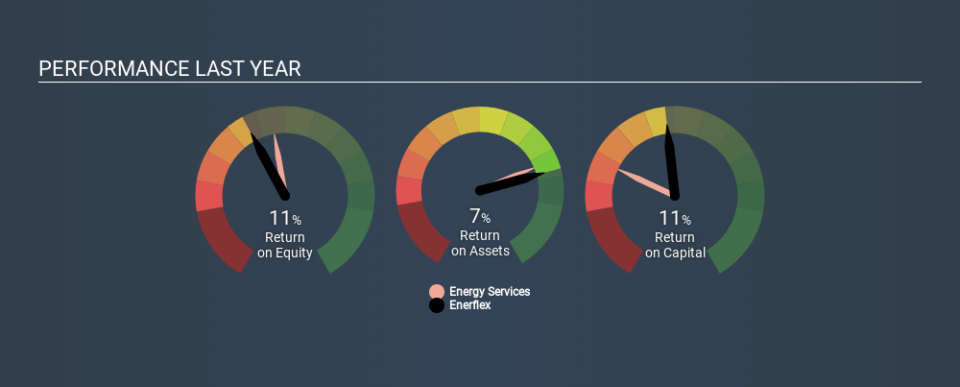Why You Should Like Enerflex Ltd.’s (TSE:EFX) ROCE

Today we are going to look at Enerflex Ltd. (TSE:EFX) to see whether it might be an attractive investment prospect. Specifically, we're going to calculate its Return On Capital Employed (ROCE), in the hopes of getting some insight into the business.
First up, we'll look at what ROCE is and how we calculate it. Second, we'll look at its ROCE compared to similar companies. Then we'll determine how its current liabilities are affecting its ROCE.
Return On Capital Employed (ROCE): What is it?
ROCE measures the amount of pre-tax profits a company can generate from the capital employed in its business. Generally speaking a higher ROCE is better. In brief, it is a useful tool, but it is not without drawbacks. Author Edwin Whiting says to be careful when comparing the ROCE of different businesses, since 'No two businesses are exactly alike.
So, How Do We Calculate ROCE?
Analysts use this formula to calculate return on capital employed:
Return on Capital Employed = Earnings Before Interest and Tax (EBIT) ÷ (Total Assets - Current Liabilities)
Or for Enerflex:
0.11 = CA$211m ÷ (CA$2.4b - CA$564m) (Based on the trailing twelve months to September 2019.)
So, Enerflex has an ROCE of 11%.
View our latest analysis for Enerflex
Is Enerflex's ROCE Good?
When making comparisons between similar businesses, investors may find ROCE useful. Enerflex's ROCE appears to be substantially greater than the 7.6% average in the Energy Services industry. We would consider this a positive, as it suggests it is using capital more effectively than other similar companies. Separate from Enerflex's performance relative to its industry, its ROCE in absolute terms looks satisfactory, and it may be worth researching in more depth.
Our data shows that Enerflex currently has an ROCE of 11%, compared to its ROCE of 4.2% 3 years ago. This makes us think about whether the company has been reinvesting shrewdly. You can see in the image below how Enerflex's ROCE compares to its industry. Click to see more on past growth.
It is important to remember that ROCE shows past performance, and is not necessarily predictive. Companies in cyclical industries can be difficult to understand using ROCE, as returns typically look high during boom times, and low during busts. This is because ROCE only looks at one year, instead of considering returns across a whole cycle. We note Enerflex could be considered a cyclical business. Since the future is so important for investors, you should check out our free report on analyst forecasts for Enerflex.
Enerflex's Current Liabilities And Their Impact On Its ROCE
Current liabilities are short term bills and invoices that need to be paid in 12 months or less. Due to the way the ROCE equation works, having large bills due in the near term can make it look as though a company has less capital employed, and thus a higher ROCE than usual. To counteract this, we check if a company has high current liabilities, relative to its total assets.
Enerflex has total liabilities of CA$564m and total assets of CA$2.4b. Therefore its current liabilities are equivalent to approximately 23% of its total assets. A fairly low level of current liabilities is not influencing the ROCE too much.
What We Can Learn From Enerflex's ROCE
Overall, Enerflex has a decent ROCE and could be worthy of further research. Enerflex looks strong on this analysis, but there are plenty of other companies that could be a good opportunity . Here is a free list of companies growing earnings rapidly.
I will like Enerflex better if I see some big insider buys. While we wait, check out this free list of growing companies with considerable, recent, insider buying.
If you spot an error that warrants correction, please contact the editor at editorial-team@simplywallst.com. This article by Simply Wall St is general in nature. It does not constitute a recommendation to buy or sell any stock, and does not take account of your objectives, or your financial situation. Simply Wall St has no position in the stocks mentioned.
We aim to bring you long-term focused research analysis driven by fundamental data. Note that our analysis may not factor in the latest price-sensitive company announcements or qualitative material. Thank you for reading.

 Yahoo Finance
Yahoo Finance 
